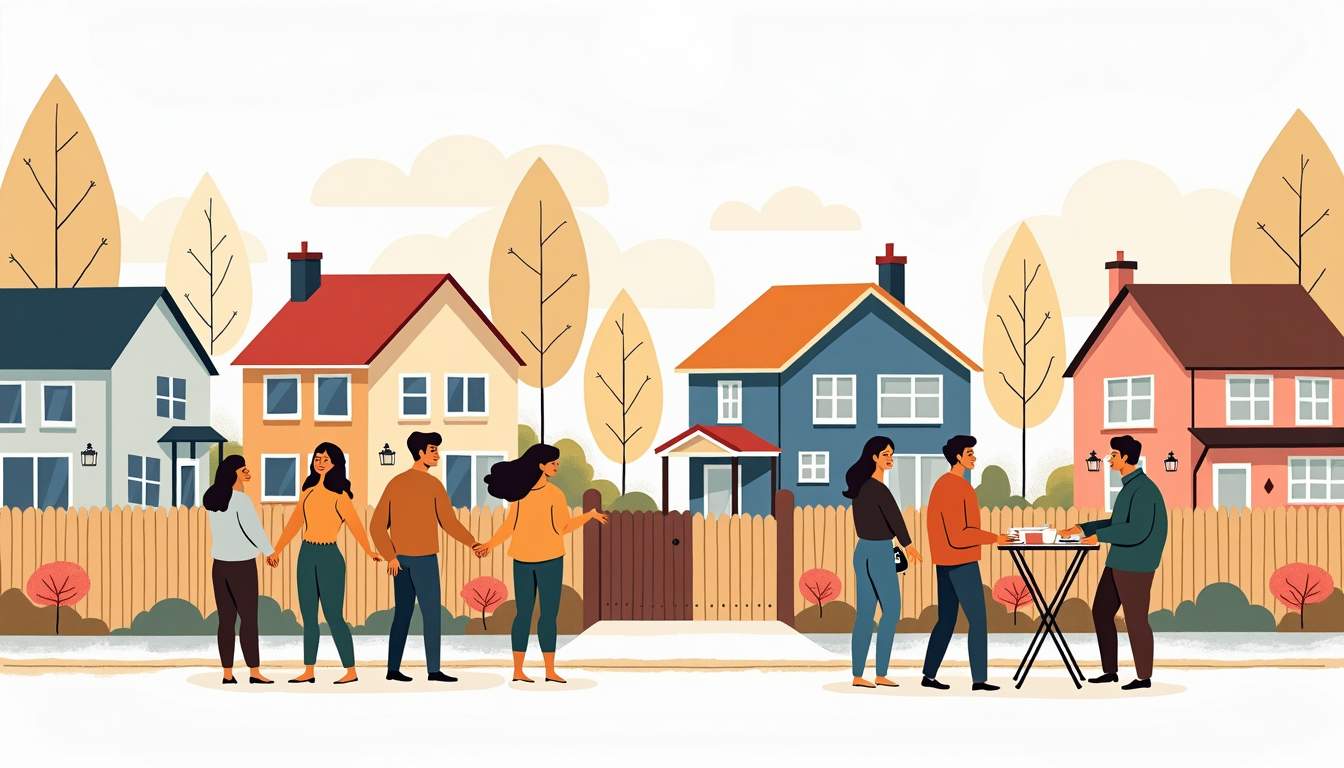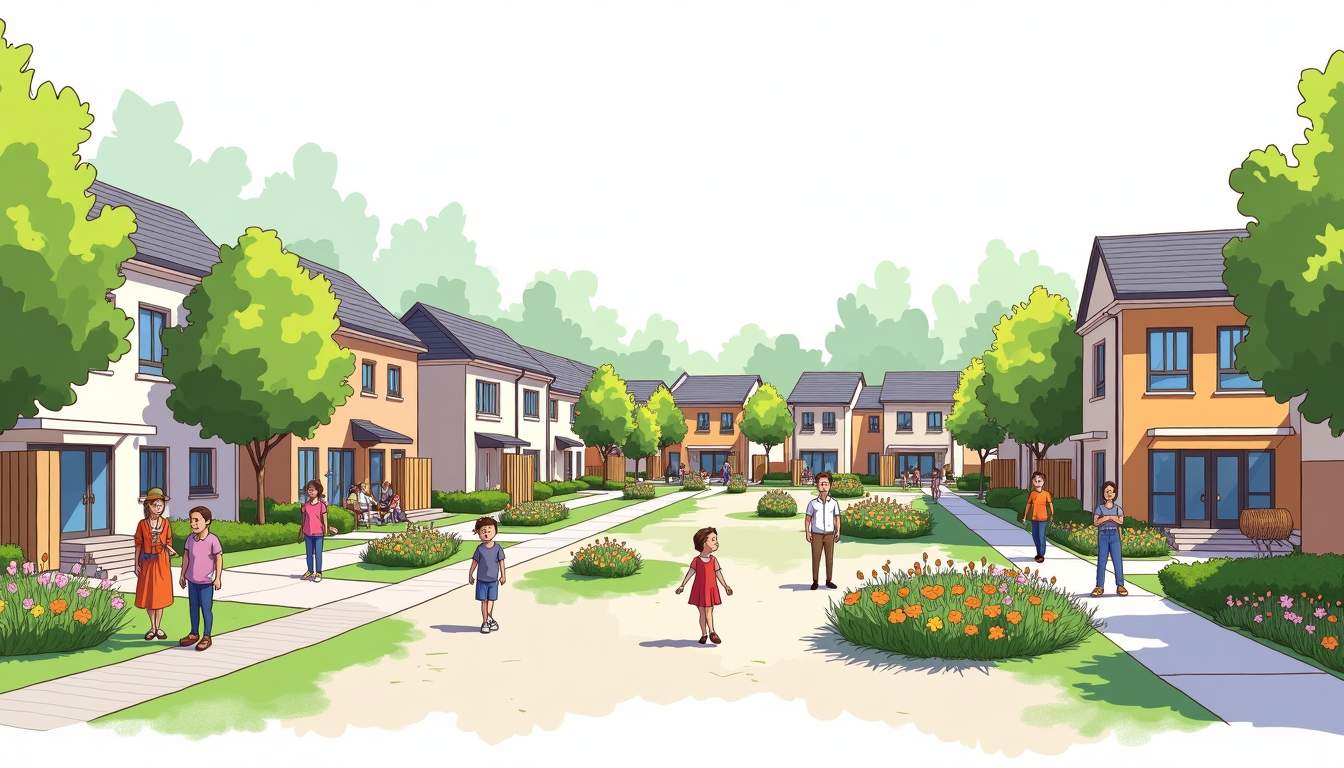
Moving to a new neighborhood is often portrayed as a logistical puzzle — packing boxes, hiring movers, transferring utilities. Yet the emotional logistics of planting roots can be just as demanding. For families, the social landscape matters: children need playmates and schools, parents look for nearby friends and support networks, and the whole household benefits from feeling connected rather than isolated. A built-in social circle — a neighborhood or community that eases social integration — transforms a house into a home more quickly and sustainably. This article explores practical ways families can find, create, and nurture that circle while settling into a new place.
Resettling disrupts routines. Children face new classrooms and unfamiliar playgrounds, while adults rebuild daily rhythms that often hinge on nearby relationships: carpools, after-school pick-ups, shared childcare, and casual conversations that turn into lasting friendships. These small interactions accumulate into a safety net that expedites adjustment.

Beyond convenience, social bonds contribute to mental and emotional well-being. Families that feel socially supported report lower stress levels, higher satisfaction with their neighborhood, and greater resiliency during transitional periods. In short, locating or cultivating a built-in social circle is not a nice-to-have; it is a core element of successful relocation.
Establishing social connections can also open doors to community resources and local knowledge that newcomers might otherwise miss. Neighbors often share tips about the best services, schools, events, and hidden gems in the area, providing a sense of belonging and grounding. These relationships create informal support networks that can assist with everything from emergency help to lending tools or sharing childcare responsibilities.
Moreover, participating in community activities, such as local clubs, volunteer groups, or hobby meet-ups, serves as a natural platform to meet others and build shared experiences. Such engagement fosters a sense of purpose and contribution, reinforcing social identity in a previously unfamiliar environment. Over time, these connections can transform a house into a true home, making the transition not just bearable but enriching.
Some neighborhoods inherently foster interaction through design and amenities. Look for areas with community parks, playgrounds, local events, community centers, and shared green spaces. These physical features create natural meeting points where children and adults can connect without the pressure of formal social arrangements.

Planned developments and co-housing communities often promote social programming and shared facilities like pools, clubhouses, or community gardens. These settings can be particularly useful for families who want immediate opportunities to meet neighbors through organized activities and volunteer roles.
In addition to physical amenities, neighborhoods with regular neighborhood association meetings or local newsletters often encourage a sense of belonging and keep residents informed about upcoming social gatherings and community initiatives. Such communication channels allow families to engage proactively and feel more integrated into the social fabric, leading to enduring relationships and neighborhood pride.
Furthermore, neighborhoods that prioritize walkability and pedestrian-friendly design tend to increase spontaneous social interactions. Sidewalks, bike paths, and traffic-calmed streets encourage residents to spend more time outdoors, where casual conversations can blossom into meaningful community ties. These areas often host seasonal festivals, farmers' markets, or block parties that offer fun, informal settings to meet others.
Choosing a neighborhood with strong, engaged schools and accessible childcare centers provides immediate social channels. Schools are a hub for parent-to-parent connections through pick-up lines, PTA meetings, school events, and volunteer opportunities. Daycares and after-school programs can also link families with similar-aged children and like-minded parents.
Local libraries, youth sports leagues, and music or art classes nearby also serve as additional platforms for family engagement. These institutions frequently offer workshops, story hours, and recitals that draw families together and stimulate friendships across different social groups. Proximity to these services can significantly enhance a family's social network while supporting children's developmental needs.
Religious institutions, cultural centers, and hobby-based clubs offer social continuity and shared values for many families. These organizations often host family-friendly events, study groups, and volunteer efforts that create reliable opportunities for deeper connections beyond casual greetings.
Additionally, participation in community theater groups, gardening clubs, or parent support networks can provide niche social environments tailored to specific interests and life stages. Engaging in these groups not only nurtures personal passions but also helps families build a stable support system within their neighborhood, fostering long-term friendships and cooperative community efforts.
Initial outreach doesn't require grand gestures. Small, consistent efforts are often the most effective. Introducing oneself to immediate neighbors, attending a local park at predictable times, and participating in school or community functions sets the stage for follow-up interactions that build familiarity and trust.

Home-based cues can help, too. Simple gestures like flagging a welcoming yard sign, hosting a casual open-house, or posting a friendly note in a community board invite conversation without obligating newcomers or neighbors. These approachable steps lower the social friction that can otherwise keep families isolated in their new homes.
Neighborhood Facebook groups, Nextdoor forums, and community listservs are modern extensions of door-to-door introductions. They enable quick discovery of parenting groups, local events, recommended services, and volunteer opportunities. However, participation should be guided by respect for existing norms: observe group tone and rules before posting, prioritize helpful contributions over self-promotion, and use private messages for one-on-one follow-ups.
Volunteering at school events, community clean-ups, or local charities puts families in proximity with others who share values and priorities. Volunteer roles can range from occasional event help to sustained leadership positions. Both produce relationships formed around shared purpose, which are more enduring than connections made solely through casual encounters.
Children’s routines naturally generate social opportunities. Regular trips to the playground, attendance at sports practice, and participation in extracurricular classes yield repeated contact with the same families, which is the backbone of neighborhood social life. Prioritizing consistency — showing up at the same times and places — helps children and parents form bonds without forcing interaction.
Also, rotational playdates and shared school responsibilities can knit families together. Creating a small network of trusted parents for swapping school pick-ups or rotating host homes reduces scheduling stress and fosters reciprocity. Over time, these practical arrangements evolve into personal friendships.
A full-fledged housewarming party can feel overwhelming; instead, consider smaller, themed meetups. Backyards or local parks are ideal for informal potlucks, storytime gatherings, or popsicle afternoons. Keeping events short, predictable, and child-centered makes attendance easier for other parents and lets relationships grow organically.
New communities benefit when families make inclusion an explicit goal. Invite neighbors from different cultural, economic, and family-structure backgrounds, and offer activities that accommodate varying schedules and needs. Intentional inclusivity builds richer networks that reflect the full diversity of a neighborhood and create stronger mutual support.
School administrators and teachers play a pivotal role in initiating social integration for new families. Welcoming committees, school buddy programs, and orientation events for parents and children reduce the awkwardness of being the new family. Schools that provide directories, parent coffees, and volunteer matchups make it much easier for families to plug in.
Encouraging cross-grade mentorship and organizing community celebrations that involve local businesses strengthens the link between school and neighborhood. Administrators who actively foster partnerships with local organizations, libraries, and parks amplify the social resources available to newcomers.
Parent-Teacher Associations and designated parent liaisons serve as bridges between families and the school community. These groups can offer newcomer welcome packets, coordinate ride-sharing, and provide platforms for social and advocacy activities. Active PTAs that welcome diverse perspectives create a more inclusive and ultimately more connected school culture.
Initial friendliness must be followed by ongoing reciprocity to become durable friendships. Simple practices—showing up for events, returning invitations, and checking in during difficult times—turn acquaintances into reliable supports. Long-term social integration also requires flexibility as family needs change: children grow, schedules shift, and different families need different kinds of help at different times.
Social resilience in a neighborhood also benefits from shared traditions. Annual block parties, seasonal festivals, or a communal holiday drive create rituals that signal belonging and continuity. These rituals enable families who move in later to plug into established social rhythms more easily.
Relying on a single point of contact is risky. Build multiple layers: immediate neighbors, school contacts, interest-based clubs, and online groups. Each layer serves distinct needs at different times, and together they create a robust social fabric that supports families through both everyday life and unexpected events.
Clear channels—like a group chat for carpool logistics or a shared calendar for neighborhood events—reduce misunderstandings and make participation effortless. Establish expectations early (for example, how long RSVPs are accepted or how to coordinate last-minute swaps) so informal cooperation becomes predictable and less stressful.
Not every neighborhood will become a permanent base. Families may move again for work, schooling, or personal reasons. Preparing for eventual transitions while still building social ties can ease future moves. Maintain contact information, exchange social media handles, and create farewell rituals that allow relationships to transform rather than dissolve abruptly.
Maintaining long-distance friendships requires intention but is feasible. Occasional visits, video calls, and shared photo albums help preserve the social capital built in a previous community, while the new environment gains a family that already knows how to foster connections.
Relocation is more than an address change; it is a social reset. Families who prioritize connecting — through neighborhood amenities, schools, volunteer work, and small but meaningful social rituals — find that a "built-in social circle" is less about luck and more about intentional choices and shared spaces. The payoff is tangible: reduced stress, practical support, and a sense of belonging that turns a house into a true home.
Creating that circle takes effort from individuals, families, schools, and neighborhood organizations. When all of these actors contribute, newcomers are welcomed, longtime residents feel renewed, and communities thrive as networks of mutual care. That collective work makes each move less solitary and more like an invitation to belong.
At Tennessee National, we understand that a true home is more than just a place to live—it’s where connections thrive and community flourishes. Offering luxury living within a vibrant gated neighborhood filled with social clubs, member events, and shared amenities, Tennessee National provides the perfect setting for families seeking a built-in social circle. Experience resort-style living enhanced by scenic nature trails, a private marina, and much more. Schedule a private tour today and begin building lasting relationships in your new home.